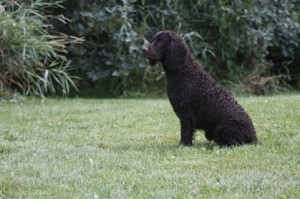Getting to Know The American Water Spaniel
 Photos and Article Courtesy of The American Water Spaniel Club
Photos and Article Courtesy of The American Water Spaniel Club
The American Water Spaniel (AWS) is a rare breed with only an estimated 3000 in existence on any given date. While the American Water Spaniel is one of the few dogs recognized as having been developed in the United States, it has never been a popular breed. The breed was reportedly developed in the Fox and Wolf River valleys of Wisconsin, where it is officially the State Dog, during the mid 1800s. It was frequently used by the market hunters of the day to help harvest all manner of game but, as the folklore says, most notably waterfowl harvested in the Great Lakes Region. In fact, even today, one will find the majority of the American Water Spaniel owners and breeders are still located in Wisconsin, Michigan, Minnesota, and surrounding states.
In the early 1900s, Doctor Pfeifer of New London, Wisconsin, was the first to recognize that the little brown spaniels, so well known in his area, were actually a distinguishable breed. It was his belief that the breed should be recognized and preserved. He led an effort to gain recognition of what would eventually be called the American Water Spaniel by petitioning the dog registries to recognize the breed. Through his efforts, the American Water Spaniel was recognized by the United Kennel Club in 1920. Over the following years others took up his cause and the breed was eventually recognized by the Field Dog Stud Book in 1938 and the American Kennel Club in 1940.
 Standing about 15″ – 18″ at the shoulder and weighing in at between 25 and 45 pounds the AWS is considered a medium sized sporting breed. It is a true dual purpose dog bred to be a companion, to live and work in close quarters, and to hunt, flush, and retrieve game of all kinds. The American Water Spaniel performs well in all endeavors but excels in the field as either a waterfowl retriever or upland flushing dog. The typical AWS is happy, energetic, and eager to please.
Standing about 15″ – 18″ at the shoulder and weighing in at between 25 and 45 pounds the AWS is considered a medium sized sporting breed. It is a true dual purpose dog bred to be a companion, to live and work in close quarters, and to hunt, flush, and retrieve game of all kinds. The American Water Spaniel performs well in all endeavors but excels in the field as either a waterfowl retriever or upland flushing dog. The typical AWS is happy, energetic, and eager to please.
American Water Spaniels are active dogs that will do best when given the opportunity to work off some of their energy. Activities like field or obedience training, runs in the park, swimming, or a good play session in the backyard are some of the ways to let a young – or old – AWS work off its pent up energy. The AWS that is not given the opportunity to work off its excess energy may develop inappropriate behaviors that will lead to frustration for both the owner and the dog.
The American Water Spaniel may not the breed for the first time dog owner. They are happiest when they know where they fit in the pack….the pack includes the human members of the family as well as other dogs. If they feel that there is a lack of leadership, they will try to fill that void. The AWS needs leadership with consistent rules enforced by the whole family. Clear leadership will provide the dog with understanding where he fits and he will be very happy to fill that role.
 AWS are quite bright and learn, and bore, quickly. Because they are independent thinkers they may surprise you with their ability to improvise. In training, long sessions of drills will likely cause the dog to shut down; shorter training sessions with variety will serve the young dog better. They may take longer to train than some other breeds.
AWS are quite bright and learn, and bore, quickly. Because they are independent thinkers they may surprise you with their ability to improvise. In training, long sessions of drills will likely cause the dog to shut down; shorter training sessions with variety will serve the young dog better. They may take longer to train than some other breeds.
While some consider the AWS to be a relatively low maintenance breed, there is no doubt that it will require grooming from time to time. The oily coat of the AWS means that regular bathing will be required. In addition, regular brushing is necessary, especially when the dog is shedding.
Being a drop ear dog, you will likely find that periodic cleaning of the ears is necessary. If you hunt your AWS in tough cover, burrs and briars will require that you spend a good amount of time combing them out at the end of the hunt.
Link to “Grooming the AWS”
http://www.americanwaterspanielclub.org/Breed/Grooming%20the%20AWS.htm
Link to American Water Spaniel Breed Standard
http://www.americanwaterspanielclub.org/Breed/Breed%20Standard.htm
Short URL: http://caninechronicle.com/?p=41852
Comments are closed











